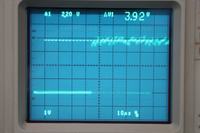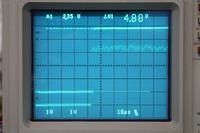TQFP
Junior Member level 3
I'm in the worst kind of situation. I have made something work, but I don't know why. Very basically:
Output from: FPGA with 3.3V I/O
Input to: Z80 (which is either HMOS or CMOS) NMI input. Z80 is 5V
Does not work, NMI is sporadic:
FPGA ---- Z80 NMI
Does not work, NMI is sporadic. Buffer is MC74VHCT125A Quad Bus Buffer Driver with 5Vcc
FPGA ----|>---- Z80 NMI
This works! Inverter is: SN74ALS04AN with 5Vcc
FPGA ----|>o----|>o---- Z80 NMI
The double inverter is just to keep the polarity of the output from the FPGA the same. The signal is asynchronous in to the Z80 and the delay presented by the inverter is irrelevant (at least is should be...)
Can anyone explain to me what is going on? My primary questions would be:
1. Why can't the FPGA directly drive the Z80's input? The FPGA's output is 3.2V loaded (I have measured it) and that is well within the specs for TTL logic '1' and also in the specs for the Z80 (according to the datasheet).
2. Why does the 74125 fail, but the 7404 works? I selected the 74125 specifically because it is a 5V device of the same "stuff" as the Z80. What am I not understanding?
Any insight would be greatly appreciated!
Thanks,
Matthew
Output from: FPGA with 3.3V I/O
Input to: Z80 (which is either HMOS or CMOS) NMI input. Z80 is 5V
Does not work, NMI is sporadic:
FPGA ---- Z80 NMI
Does not work, NMI is sporadic. Buffer is MC74VHCT125A Quad Bus Buffer Driver with 5Vcc
FPGA ----|>---- Z80 NMI
This works! Inverter is: SN74ALS04AN with 5Vcc
FPGA ----|>o----|>o---- Z80 NMI
The double inverter is just to keep the polarity of the output from the FPGA the same. The signal is asynchronous in to the Z80 and the delay presented by the inverter is irrelevant (at least is should be...)
Can anyone explain to me what is going on? My primary questions would be:
1. Why can't the FPGA directly drive the Z80's input? The FPGA's output is 3.2V loaded (I have measured it) and that is well within the specs for TTL logic '1' and also in the specs for the Z80 (according to the datasheet).
2. Why does the 74125 fail, but the 7404 works? I selected the 74125 specifically because it is a 5V device of the same "stuff" as the Z80. What am I not understanding?
Any insight would be greatly appreciated!
Thanks,
Matthew

